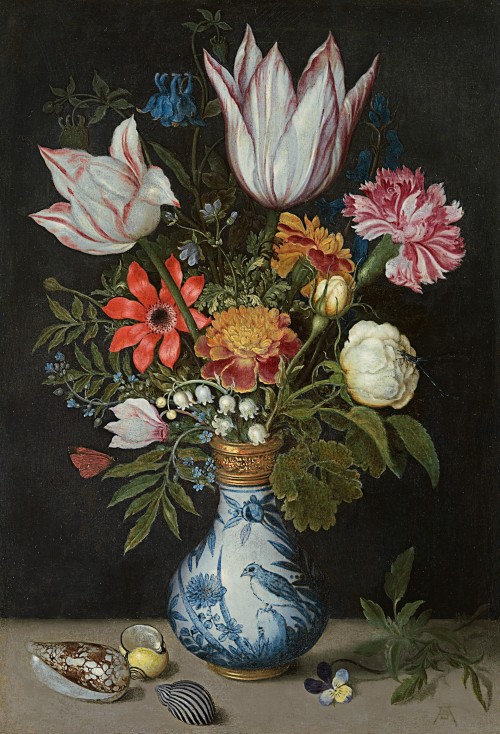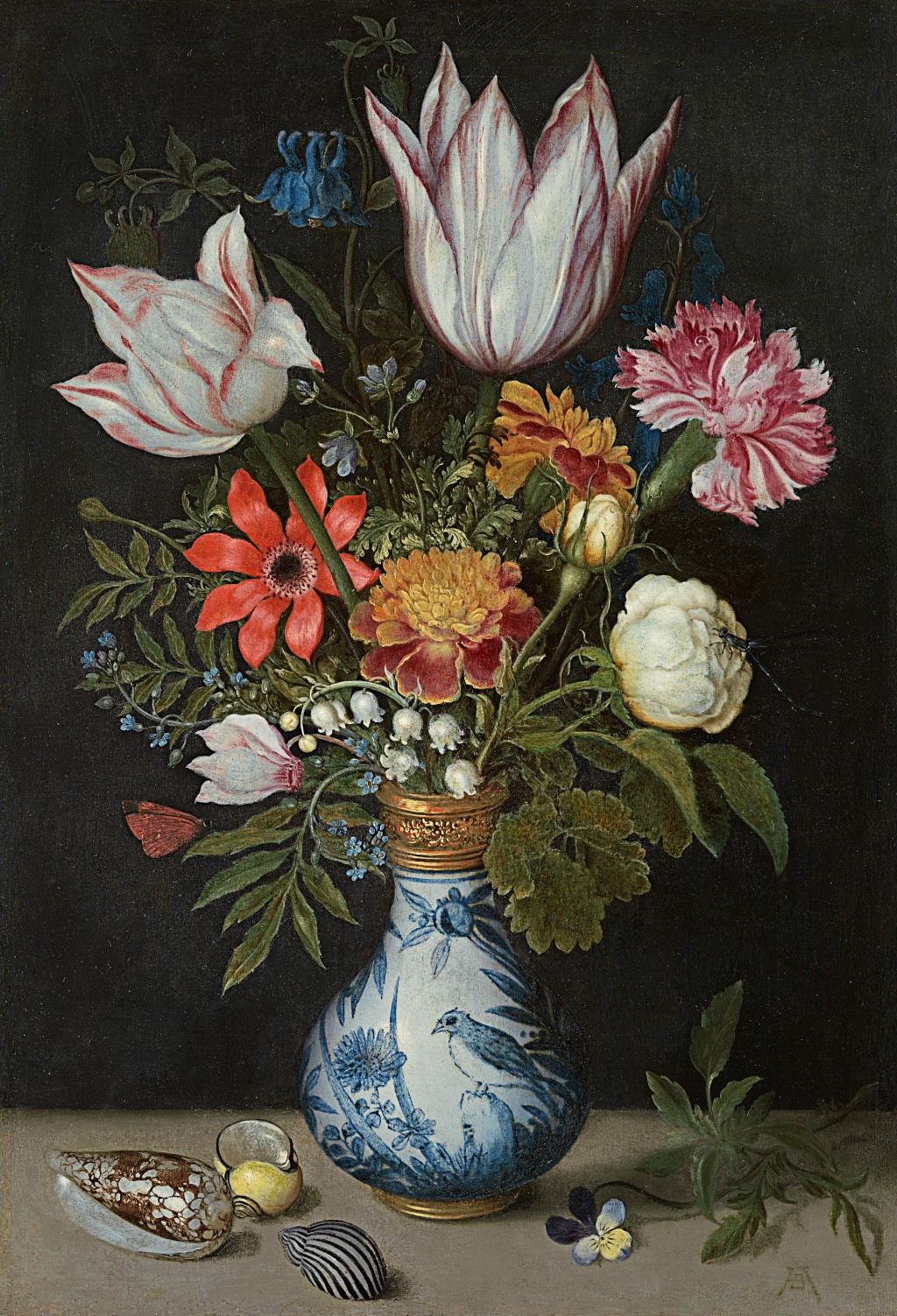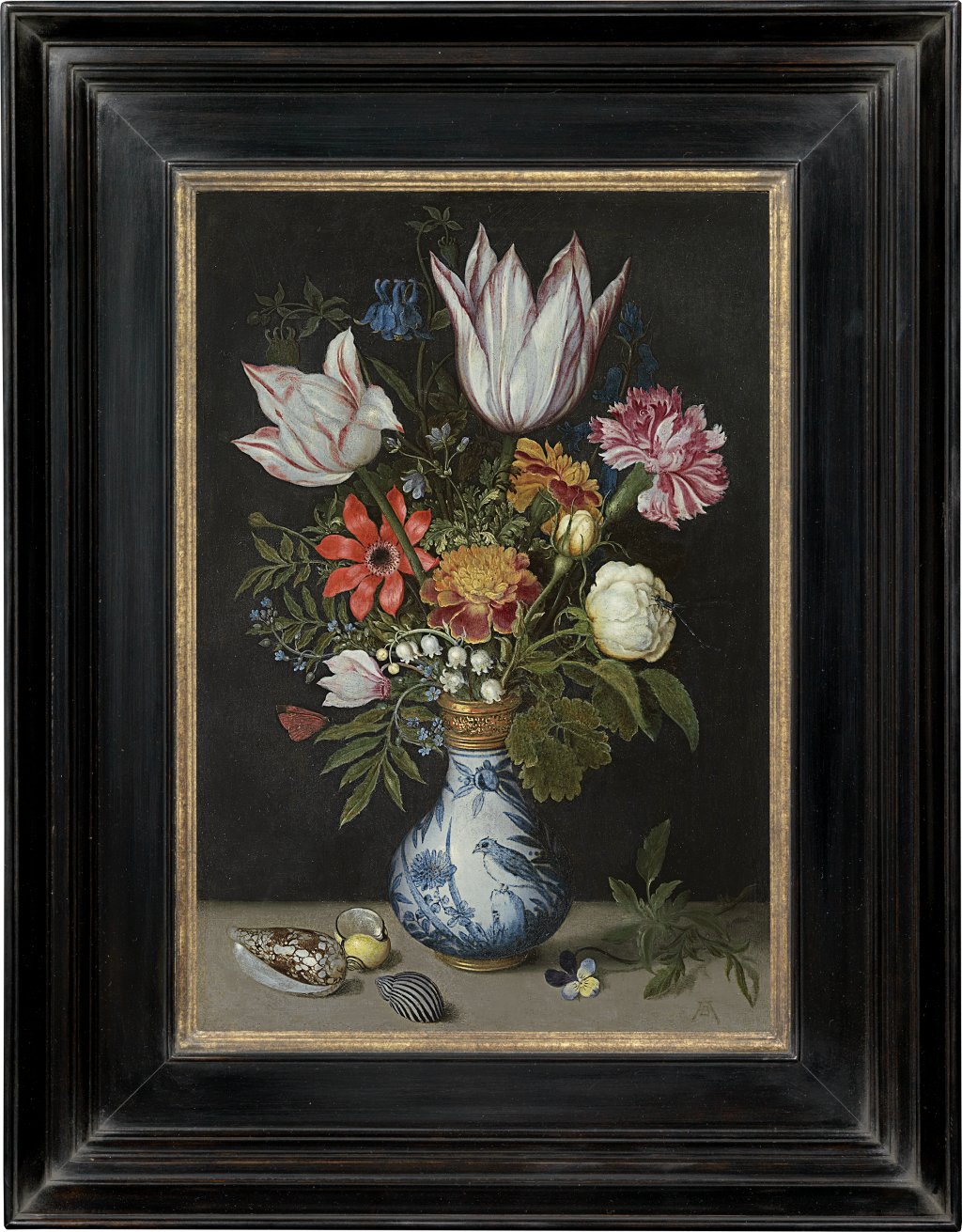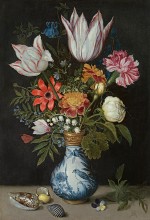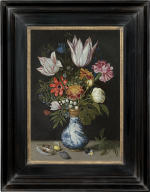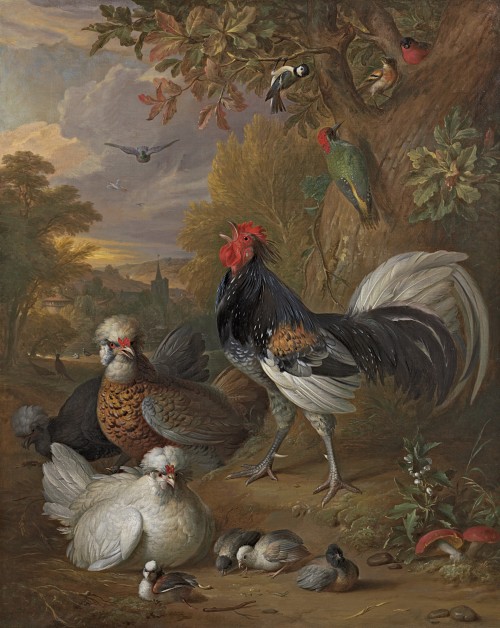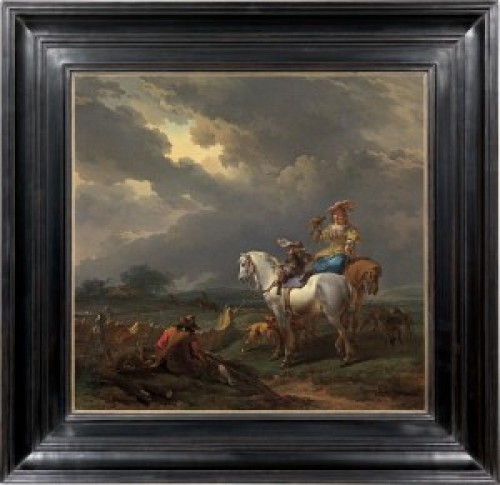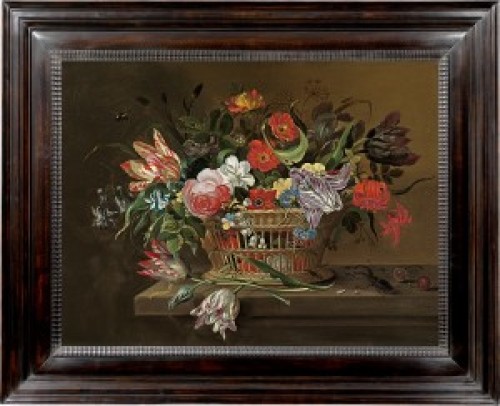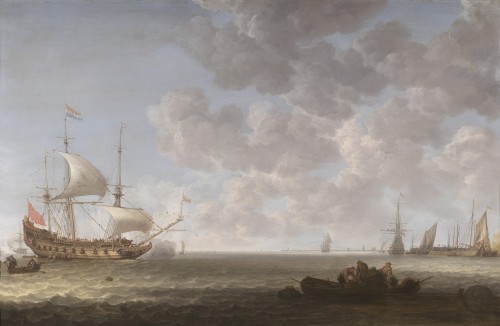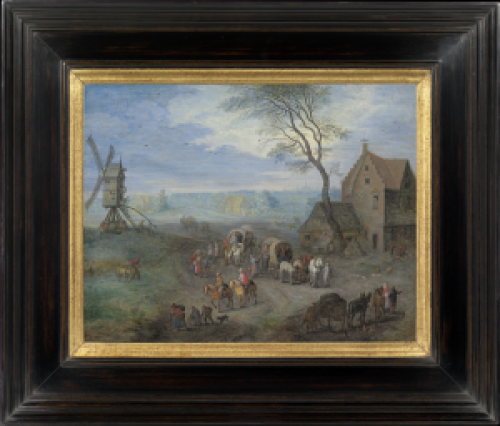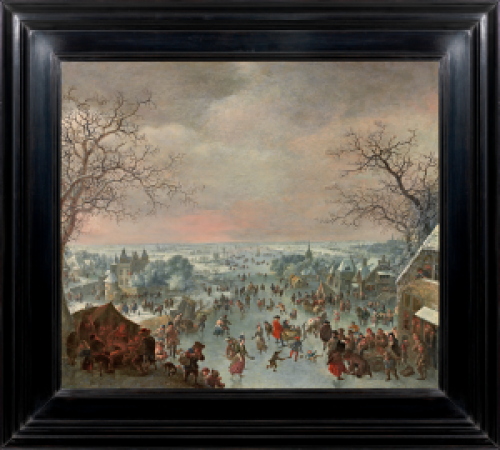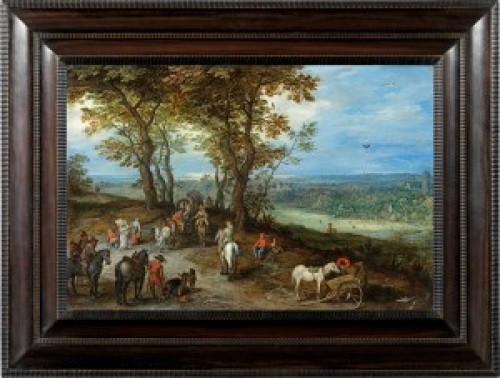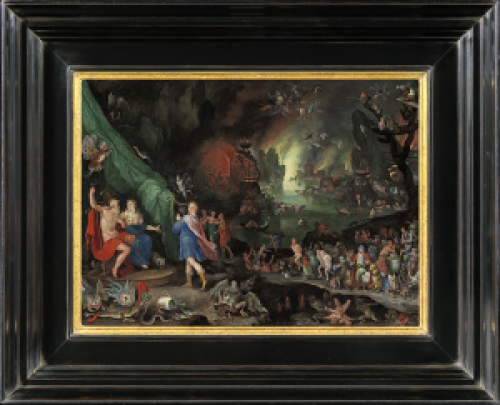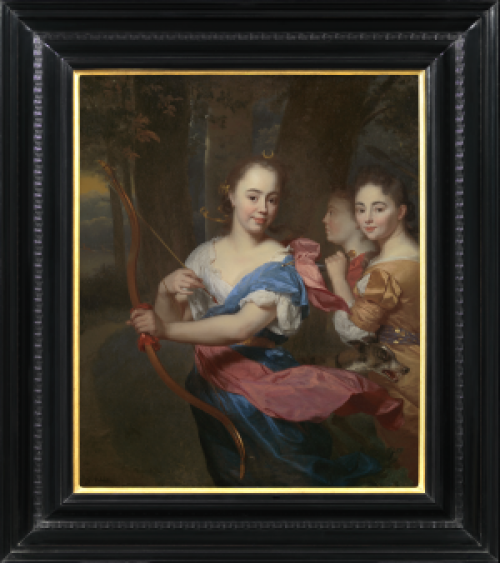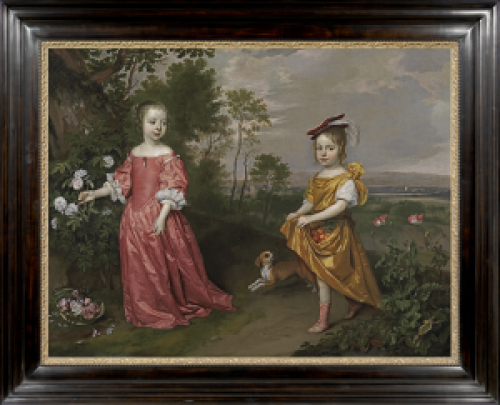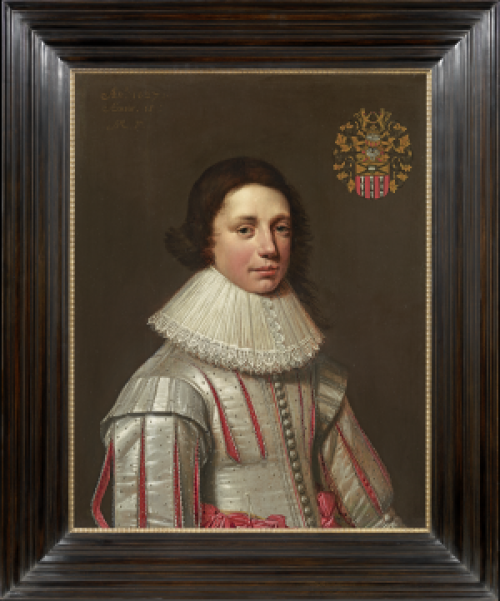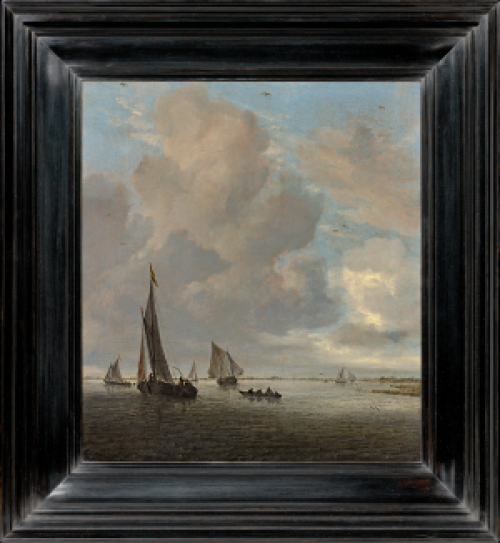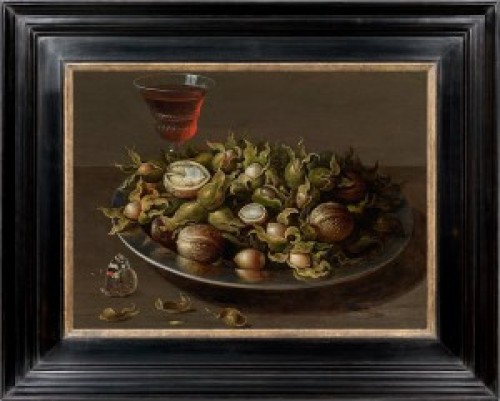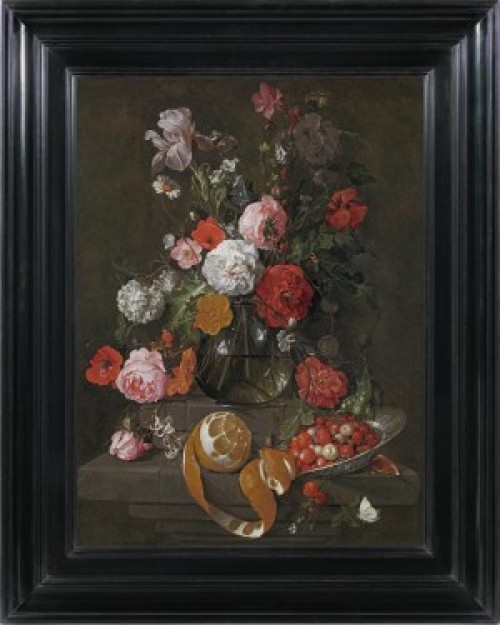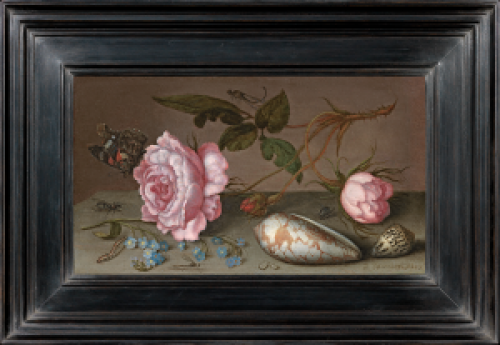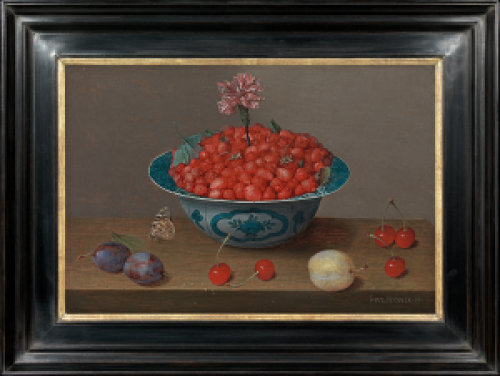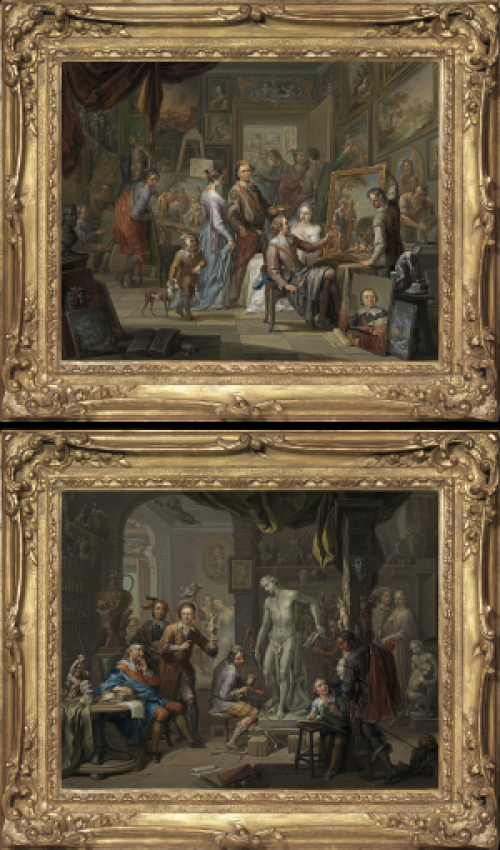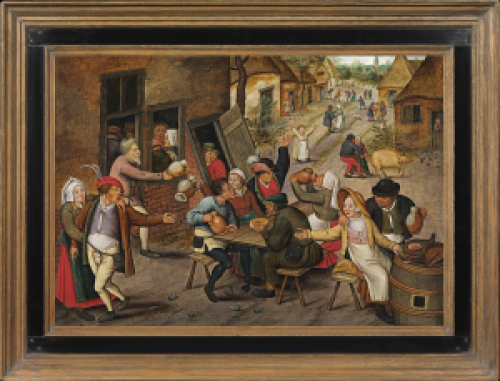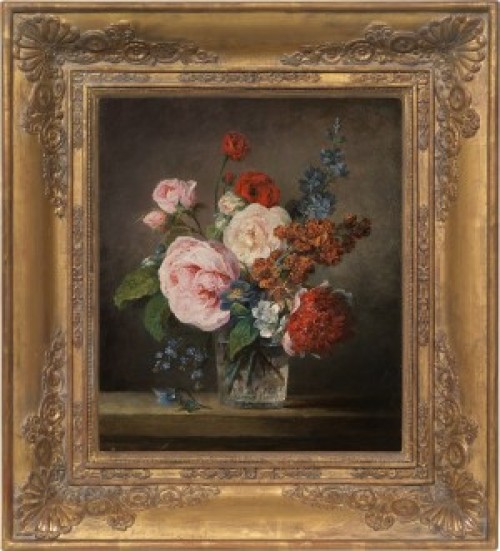AMBROSIUS BOSSCHAERT THE ELDER
Antwerp 1573 - 1621 Hague
Ref: CB 189
A still life of tulips, roses, lilies-of-the-valley, forget-me-nots, cyclamen and other flowers in a silver-gilt-mounted Wanli vase, with shells and a pansy on a ledge
Signed with monogram lower right: .AB. (in ligature)
Oil on copper: 11 ¼ x 7 5/8 in / 28.6 x 19.4 cm
Frame size: 16 x 12 ¼ in / 40.6 x 31.1 cm
Painted circa 1619-20
Provenance:
Henri Heugel (1844-1916), Paris;
by descent
Leonard Koetser, London and New York, by 1961
Robert Hilton Smith (1928-2009), Washington DC and Crystal City, VA, by 1969
Brod Gallery, London, by 1975
Christie’s New York, 2nd June 1988, lot 103;
Richard Green, London
Baron Harris of Peckham;
Sotheby’s London, 4th July 1990, lot 31;
where acquired by Ann Getty (1941-2020) and Gordon Getty (b.1933)
Exhibited:
London, Brod Gallery, catalogue 1975, no.1, illus.
Maastricht, Brod Gallery, Pictura, 1975, p.75, illus.
Literature:
Sam Segal, ‘Balthasar van der Ast’, in Masters of Middelburg: Exhibition in the Honour of Laurens J Bol, Kunsthandel K&V Waterman BV, Amsterdam 1984, pp.50; 61, note 10
Ambrosius Bosschaert was a pioneering flower painter who spawned a dynasty. Among his pupils were his sons Johannes (c.1607-1628/29), Ambrosius II (1609-1645) and Abraham (1612/13-1643); his brothers-in-law Balthasar (1593/4-1657) and Johannes van der Ast (before 1593-after 1618) and his son-in-law Jeronimus Sweerts (1603-1636). Ambrosius was born in Antwerp in the Spanish Netherlands in 1573 and moved with his parents to Middelburg on the northern side of the Scheldt estuary c.1589. Being Protestants, the family would have been given four years from the Sack of Antwerp in 1585 to settle their affairs and leave the city. As often happens with the law of unintended consequences, the flood of mercantile and middle-class refugees brought renewed vigour and expertise to the northern Netherlands. Middelburg, a prosperous trading centre and the capital of Zeeland, was renowned for its botanical gardens. There was a ferment of interest in exotic plants, such as irises and tulips, imported from the Balkans, the Near and Far East, and the New World, which formed the basis for the Dutch horticultural industry. This in turn fostered the interest in flower painting, which had been developed as an independent genre by practitioners such as Jan Brueghel the Elder (1568-1625) in the first decade of the seventeenth century.
Ambrosius Bosschaert lived in Middelburg until 1613, briefly in Amsterdam and Bergen op Zoom and from 1615-19 in Utrecht. In 1619 he moved to Breda. He could command handsome sums for his paintings: a lawsuit mentions 200 guilders for a basket of flowers and 240 guilders for a large vase of flowers. Bosschaert died in 1621 in The Hague while delivering a flower piece to the Steward of Maurits, Prince of Orange-Nassau, for which he was asking 1,000 guilders[1].
The present Still life of tulips was made c.1619-20, when Bosschaert was at the height of his powers. The copper support (more expensive than an oak panel) allowed for an extremely fine degree of finish. Sam Segal comments on the ‘tremendous translucency and fine satin finish’ characteristic of Bosschaert’s style, which was ‘achieved by applying layers of coloured glaze, using the technique of the fine painters to smooth away all traces of the brush, thus making the brushstrokes nearly invisible’[2]. Segal also notes the ‘harmonious atmosphere’ of his paintings[3]. There is a velvety aura to each of Bosschaert’s flowers that gives them a jewel-like quality.
Bosschaert here groups together flowers which bloom across spring and summer, from the tulips of March and April to the roses and carnations of May and June. The bouquet would have been assembled from drawn or painted studies kept in the studio for reference. Bosschaert crowns the arrangement, as he so often does, with two exquisitely observed tulips. These flowers, which had mythic status in the Ottoman world, became an obsession of the Dutch when they were imported into Europe in the mid-sixteenth century. The stripes on Bosschaert’s purple and scarlet tulips were caused by a virus which eventually weakened the plant, although this was not understood at the time. The fascination was to see which bulbs would ‘break’ into these beautiful flame-like markings. By the mid-1630s, tulips had become an investment bubble in which single bulbs allegedly changed hands for the price of an Amsterdam mansion. When the bubble burst, in 1637, many were ruined.
Bosschaert gives sculptural solidity to the flowers by placing them against a dark background and putting warm- or light-coloured blooms, such as the African marigold and white rose, at the front of the bouquet. Imposing, rounded or spiky flowers are set against a filigree of leaves and smaller flowers in cool colours, such as the blue columbine at the top of the bouquet and the blue cranesbill between the two tulips. The exotic flowers, like other elements of the composition, reflect the international trade of early modern Europe and the passion for horticulture of that era. As well as the tulips, originally from the Near East, the composition features ‘African’ marigolds, in fact native to Mexico; an anemone, from southern Europe and a carnation from the Mediterranean. Roses, though long grown in northern Europe, were originally native to Asia. All could be found in the well-kept gardens of Middelburg by Bosschaert’s day.
The delicious, pearly arc of the lily-of-the-valley, juxtaposed with tiny, star-like forget-me-nots, echoes the pristine blue and white of the Wanli porcelain vase. The Portuguese near-monopoly on trade with China was challenged by the founding of the Dutch East India Company (Verenigde Oost-Indische Company, or VOC) in 1602. In 1602-3 the Dutch captured two Portuguese ships laden with porcelain. The cargoes were sold in Middelburg and Amsterdam at a healthy profit, sparking even greater enthusiasm for this luxury product, the technology for which was as yet unknown in the West. The rare and precious nature of Bosschaert’s blue-and-white vase is underlined by the fact that it is mounted in gold (or silver-gilt) to protect against chips. It is the perfect container for the artist’s exquisite flowers, each one precious and unique, each the product of God’s Creation.
The third element of the painting is provided by the shells, avidly collected and placed in kunstkammers (cabinets of curiosities) comprised of marvels of nature and of man. They too reflect an age of exploration and colonization, when treasures from all over the world flowed into the Dutch Republic. The marbled Conus shell (Conus omaria) on the far left is from the Indo-Pacific region, while the black and white striped Neritina shell (Neritina turrita) comes from Indonesia. Dutch sailors reached Indonesia to buy spices in the 1590s. In 1602 the VOC was granted a charter to wage war, build fortresses and make treaties across the region; trading developed into the colonization of what became the Dutch East Indies, which lasted until the 1940s. Bosschaert’s shells arrived in the Netherlands in the first few heady decades of this discovery of the East.
The third shell, a brilliant lemon-yellow with an elegant trim of black, is an example of a Painted Snail (Polymita picta), a land snail endemic to eastern Cuba. Coming in a variety of dazzling colours, they were much sought-after, then as now, to the extent that the snails are now endangered. Bosschaert may be making a gentle joke that Nature’s ‘painting’ is as skilled as his own; shells were also traditionally used to store pigments. Cuba was a Spanish colony, but the Dutch West India Company was active in the Caribbean throughout the seventeenth century.
Elements of this bouquet can be found in other paintings by Bosschaert, derived from the same studio drawings. A similar marigold and a columbine between two tulips can be found in an oil on copper Still life with flowers in a Wanli vase, signed with monogram and dated 1619, in the Rijksmuseum, Amsterdam[4]. It shares with the present painting a silver-gilt-mounted Wanli vase, though the floral pattern on the vase is different[5]. The bluebell, damsel fly and Polymita picta shell can be seen in another painting on copper of 1619, Bouquet of flowers on a ledge, in the Edward W Carter Collection at the Los Angeles County Museum of Art[6].
Bosschaert’s brother-in-law and pupil Balthasar van der Ast made a meticulous copy of the present painting, probably around 1622, signed with his monogram B.V.A. (private collection)[7]. Van der Ast executed this version to a high standard and made minor changes in the foreground to stamp the work as his own. He moved the striped Neritina shell to the centre of the painting and substituted Bosschaert’s pansy on the ledge, which gives such three-dimensionality to his composition, with a small fly.
Ambrosius Bosschaert the Elder, Still life with flowers in a Wanli vase, signed with monogram and dated 1619. Rijksmuseum, Amsterdam.
Balthasar van der Ast (1593/4-1657), Flowers in a Wanli vase, c.1622.
Private collection.
Flower key[8]
1 Lily-of-the-valley Convallaria majalis L.
2 Forget-me-not Myosotis scorpioides L.
3 Sowbread Cyclamen hederifolium Ait.
4 African marigold Tagetes patula L.
5 Windflower Anemone hortensis L.
6 Meadow cranesbill Geranium pratense
7 Bordered tulip Tulipa cf. agenensis DC x T. schrenkii Reg.
8 Columbine Aquilegia vulgaris L.
9 Flamed tulip Tulipa schrenkii Reg. x T. cf. stellata Hook.
10 Bluebell Scilla non-scripta
11 Carnation Dianthus caryophyllus L.
12 White rose Rosa x alba L.
13 Pansy (heartsease) Viola tricolor L.
a Conus Conus omaria Hwass: Indo-Pacific
b Polymita Polymita picta (Born.): Cuba, endemic
c Neritina Neritina turrita (Gmel.): Indonesia
d Damsel fly Coenagrion puella (L.)
e Butterfly ? Erebia medusa Denis et Schiff.
[1] See Sam Segal and Klara Alen, Dutch and Flemish Flower Pieces, vol. I, Leiden 2020, pp.192-4.
[2] Segal and Alen, op. Cit., pp.192-3.
[3] Ibid., p.193.
[4] Oil on copper: 12 ¼ x 8 ¾ in / 31 x 22.5 cm.
[5] We are very grateful to Ben Janssens of Ben Janssens Oriental Art, who comments that the vase is untypical both in shape and decoration to Wanli wares and was probably an invention by Bosschaert, based on his admiration for Chinese blue and white porcelain.
[6] 11 x 9 in / 27.9 x 22.8 cm.
[7] Oil on panel: 11 ½ x 7 ¾ in / 29.2 x 20 cm.
[8] We are grateful to Celia Fisher for the identification of the flower species.

